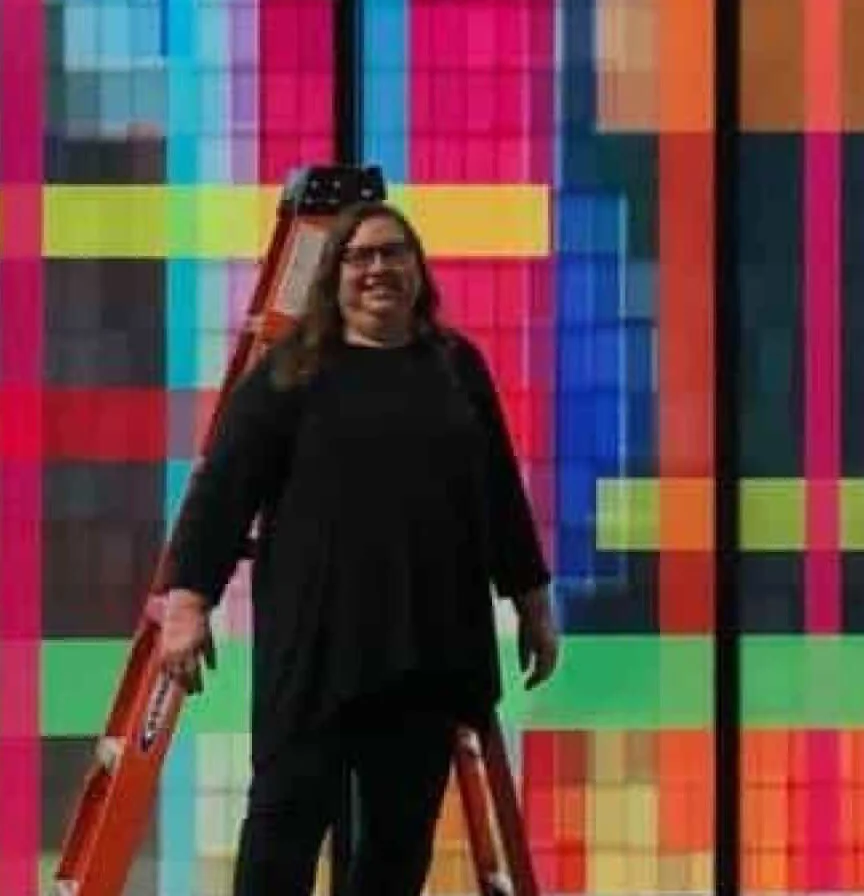About JAF: Grantees
About George King
George King and Lonnie Holley (Courtesy Atlanta Contemporary Art Center)
An interview with Deanna Sirlin, The Art Section
George King is a filmmaker who has been working on a film about Lonnie Holley's life and work. The Art Section's Deanna Sirlin interviewed him about his project by email.
Click here to see a trailer for Thumbs Up For Mother Universe: a Lonnie Holley Story
DS: How did you come to know about Lonnie Holley?
GK: In the early 1990s, Lonnie’s work was known to Atlanta artists and “cultural cognoscenti.” He had created this mammoth art environment on a hillside next to the Birmingham Airport. To call it just a yard show diminishes the scale. I called him up and spoke to his youngest daughter, Carlonie, who must have been eight years old at the time. She relayed messages back and forth between Lonnie and me. He said, “Sure. Come on over and visit.” So I did. I met this charming, energized man who devoted his afternoon to showing us his work and interpreting the complex narratives that underlie all his art. My camera-person, Sylvia Jackson, and I left with gifts. Did I suspect this would be the beginning of a near 20-year project? Er, no.
DS: Why did you decide to make this film?
GK: At the time I became aware of Lonnie’s work, I was bored by the “clever,” but as I saw it, sterile and self-referential visual art scene. Remember those young Turks driving their Rolls Royce’s around New York City? In contrast, I had seen work created mainly by Southern, African American artists that was characterized by content and passion. I had interviewed a number of collectors, curators, and others about this work. When I met Lonnie, I realized that his energy and talent, coupled with his passion to communicate, made him the perfect subject to address some of the questions surrounding this work.
Since I have been filming Lonnie he has been jailed, shot at by neighbors, beaten up by the police, and evicted from the land homesteaded by his grandfather. His famed “art environment” was bulldozed under, and much of his art stolen and destroyed. But somehow Lonnie has outwitted history, circumstance, and the ignorance of others to emerge as a star in the firmament of American culture. His story is one of endurance, faith, and overcoming unfathomable odds to succeed. I also want the audience to look beyond their assumptions about who makes art and why, and to consider the capacity for art to change our lives.
Lonnie Holley, still from The Lonnie Holley Story (Camera: Jack Frost)
DS: Why did you choose to chronicle Holley’s life over a long period of time as opposed to making a portrait at a given moment? Have your perception of Holley and the purpose of your film changed over time?
GK: When I first encountered Lonnie and his art making, I watched two or three short films people had already made about him. They were basically the same film—“Lonnie Holley makes a piece of art.” I was more interested in how and why Lonnie makes art, the social realities of his family, and the black community he lived in that was destroyed to build the expanding Birmingham Airport.
I did not deliberately set out to make a film spanning 20 years. (Ironically, my initial efforts to raise money for the film were half-hearted and unsuccessful. Rejected by funders, I shrugged and pressed on.) I was able to delve into interesting aspects of Lonnie's world--his family, his daily life, his friends, the places he hung out. Over time, trust developed and doors opened. I now have an archive of video, audio, photographs, and experiences. I could, and might, make multiple films. As of now, my goal is to make a feature-length documentary that will serve to introduce viewers to Holley and his world. If they want to go deeper, a website of images and sounds, narratives, music, and raw data will ‘surround’ the film itself. The film will function in part as a marketing device to drive people to the archive.
Lonnie Holley, unidentified photographer
DS: What has making the film led you to understand about Lonnie Holley and what do you want your audience to understand about Lonnie Holley when they see your film?
GK: Lonnie makes art all the time—and that is ALL the time. But he doesn't make it to sell--although his art and music are his only source of income. He makes art to engage and teach people about African American history and culture, the environment, and other themes that are important to him. He makes art to leave a mark—I was here, I did this. And he makes art, as I see it, to quiet the pain of an anguished and loveless childhood, and because it is a satisfying outlet for his phenomenal energy.
Because sometimes the work is so ephemeral, whenever he makes something small or large he wants to document that it existed. He often leaves his art in woods, by the side of the road, or in one case, at the bottom of a river. Following him with a camera, I fulfill his need for documentation. By now we share a great deal of history. We have been down the creeks and ditches, walked the railroad tracks, and visited the junkyards and thrift stores; and I am close to many of his family members. Lonnie wants this story told so people understand how and why he makes art, and why we should all engage our creativity and protect the planet. "Thumbs up for Mother Universe!"
DS: We know you’re trying to raise money to complete the project. What remains to be done and how can people help? Is there anything else you’d like to let people know about this film?
GK: The funding for documentary filmmaking is in continuous flux. Television has always had tremendous influence--good and bad--on nonfiction filmmakers. Today, reality TV and the Internet have, I believe, sadly compromised complex, thoughtful work. Films are expensive. The funding environment is incredibly competitive. I recall a conversation with a filmmaker who won the Grand Jury Prize at Sundance and then struggled to get his next film funded inside the United States. I have just finished a crowd-funding campaign through Indiegogo. It was a huge amount of work. We raised over $30,000 but it will cost probably over $150,000 to finish the film.
POSTSCRIPT: The film was completed in early 2020. The premier and other screenings were delayed and complicated by the COVID-19 pandemic, but the filmmakers persisted. The film won the Audience Award at its first film festival screening, Fine Arts Film Festival in L.A. and went on to win Best Documentary award at the Bronze Lens Film Festival (Atlanta), the Audience Award: Best Documentary Feature at the Tallgrass Film Festival (Wichita KS), the Audience Award Best Feature Film at the Black Harvest Film Festival (Chicago), Daniel Wood Audience Award, Fine Arts Film Festival (Venice, CA), and Best Documentary at the Harlem International Film Festival (NYC). So far! The film will be screening at the American Folklorists Society’s annual meeting in October 2021. Once the festival screenings in 2021 are completed, the filmmakers will seek distribution to reach audiences worldwide. They anticipate the film will be available to the public via streaming and DVDs in summer 2022.
Click here to read the original article at theartsection.com.
Click here for The New Yorker article about Lonnie Holley, October 2018.
Click here for a story about Lonnie Holley from The Bitter Southerner.
Click here for Lonnie Holley's website.
George King is a British documentary filmmaker based in Atlanta, Georgia. He has written, produced and directed theater, radio, and film projects such as Word of Mouth, Bananaland, Goin' to Chicago, Will the Circle be Unbroken?, and Ten Thousand Points of Light, among others. Currently King is in production on two documentary features, The Lonnie Holley Story, and Kick Like Me.
Click here for George King's website.
Deanna Sirlin is the Editor-In-Chief of The Art Section and an artist.
Click here for Deanna Sirlin’s website.





